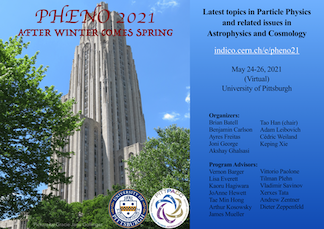Conveners
Neutrino III
- Pedro Machado
Neutrino oscillations in matter provide a unique probe of new physics. Leveraging the advent of neutrino appearance data from NOvA and T2K in recent years, we investigate the presence of CP-violating neutrino non-standard interactions in the oscillation data. We first show how to very simply approximate the expected NSI parameters to resolve differences between two long-baseline appearance...
Neutrinos lose coherence as they propagate, which leads to the fading away of oscillations. In this work, we model neutrino decoherence induced in open quantum systems from their interaction with the environment. We first present two different models in the quantum mechanical framework, in which the environment is modeled as forced harmonic oscillators with white noise interactions, or...
We study the sensitivity to axial nucleon structure of single-spin asymmetries in (anti)neutrino charged current quasielastic scattering on free nucleons. In contrast to electromagnetic processes, the parity-violating weak interaction gives rise to large single-spin asymmetries at leading order. Future polarization measurements could provide independent access to the proton axial structure and...
Besides the usual mechanism of light Majorana-neutrino exchange nature might have chosen (additional) different mechanisms which could induce neutrinoless double beta decay ( $0\nu\beta\beta$). We studied possibilities on how to experimentally distinguish different $0\nu\beta\beta$-mechanisms on an EFT basis. Additonally, we are developing a general purpose tool to calculate $0\nu\beta\beta$...
This talk presents a model of the electron-like excess observed by the MiniBooNE experiment comprised of oscillations involving a new mass state, $\nu_4$, at $\mathcal{O}(1)$ eV and a high mass state, $\mathcal{N}$, at $\mathcal{O}(100)$ MeV that decays to $\nu+\gamma$ via a dipole interaction.
Short baseline oscillation data sets (omitting MiniBooNE appearance data) are used to predict the...
We have analyzed new contributions to the muon anomalous magnetic moment in a class of models that generates a naturally large transition magnetic moment for the neutrino (needed to explain the XENON1T electron recoil excess). These models are based on an approximate $SU(2)_H$ symmetry that suppresses the neutrino mass while allowing for a large neutrino transition magnetic moment. We have...
We consider the generation of neutrino masses via a singly-charged scalar singlet. Under general assumptions we identify two distinct structures for the neutrino mass matrix. This yields a constraint for the antisymmetric Yukawa coupling of the singly-charged scalar singlet to two left-handed lepton doublets, irrespective of how the breaking of lepton-number conservation is achieved. The...
FASER$\nu$ at the LHC is designed to directly detect collider neutrinos for the first time and study their cross sections at TeV energies, where no such measurements currently exist. The detector will be located 480 m downstream of the ATLAS interaction point. With FASERnu, the three-flavor neutrino cross-sections will be measured in the currently unexplored energy range between 360 GeV and 5...
